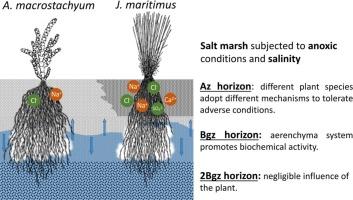Rhizosphere properties in salt marshes are shaped by both soil genetic horizons and halophyte species
IF 5
2区 农林科学
Q1 SOIL SCIENCE
引用次数: 0
Abstract
Salt marshes are harsh ecosystems due to seawater intrusion that causes waterlogging and salt accumulation in soil. Halophytes are the primary species able to resist these stress conditions by impacting physicochemical and biological properties of the rhizosphere. This study investigated how properties of soil genetic horizons affect soil enzyme activities under two halophytes (Arthrocaulon macrostachyum and Juncus maritimus) and examined changes in bulk and rhizosphere soil properties under salt and hypoxia stress. Results indicated that organic matter was the primary driver of biological activity in the superficial horizon (Az), particularly under J. maritimus. This is supported by the elevated enzyme activity recorded under this halophyte, which corresponded with higher levels of total organic carbon and its fractions content. In contrast, A. macrostachyum mitigated salinity stress by reducing salt accumulation in the Az horizon compared to J. maritimus, showing a threefold decrease in the content of cations and anions. The anoxic conditions caused by the rising water table reduced biochemical processes in the bulk soil of Bgz horizon under both plant species compared to the rhizosphere. In response, plants enhanced potential enzyme activity in the rhizosphere (on average, three times higher than bulk soil), likely due to plant-soil gas exchange mechanisms. In contrast, the decrease in root abundance and coarser soil texture of the 2Bgz horizon regulated the chemical and biochemical behaviour of the horizon itself. Overall, halophyte adaptability to harsh conditions such as those in salt marshes is influenced by numerous factors, including a significant association with soil genetic horizon properties and plant species. Therefore, assessing soil by genetic horizons rather than fixed depths facilitates a more accurate understanding of tolerance mechanisms under field conditions.

盐沼根际特性是由土壤遗传层和盐生植物种类共同决定的
盐沼是严酷的生态系统,因为海水入侵会导致内涝和土壤中的盐分积累。盐生植物是能够通过影响根际的物理化学和生物特性来抵抗这些胁迫条件的主要物种。研究了两种盐生植物(节肢植物和海带植物)土壤遗传层性质对土壤酶活性的影响,并研究了盐和缺氧胁迫下块状土壤和根际土壤性质的变化。结果表明,有机质是浅层(Az)生物活性的主要驱动因子,特别是在海苔下。这是由盐生植物下记录的酶活性升高所支持的,这与较高的总有机碳及其组分含量相对应。与海苔相比,大青竹通过减少Az层的盐积累来缓解盐胁迫,其阳离子和阴离子含量降低了三倍。与根际相比,地下水位上升引起的缺氧条件降低了两种植物下Bgz层体土壤的生化过程。作为回应,植物提高了根际的潜在酶活性(平均比散装土壤高3倍),可能是由于植物-土壤气体交换机制。相比之下,2Bgz地层根系丰度的减少和土壤质地的粗糙调节了地层本身的化学和生化行为。总体而言,盐生植物对盐沼等恶劣条件的适应性受到许多因素的影响,包括与土壤遗传水平特性和植物物种的显著关联。因此,通过遗传层而不是固定深度来评估土壤,有助于更准确地了解田间条件下的耐受性机制。
本文章由计算机程序翻译,如有差异,请以英文原文为准。
求助全文
约1分钟内获得全文
求助全文
来源期刊

Applied Soil Ecology
农林科学-土壤科学
CiteScore
9.70
自引率
4.20%
发文量
363
审稿时长
5.3 months
期刊介绍:
Applied Soil Ecology addresses the role of soil organisms and their interactions in relation to: sustainability and productivity, nutrient cycling and other soil processes, the maintenance of soil functions, the impact of human activities on soil ecosystems and bio(techno)logical control of soil-inhabiting pests, diseases and weeds.
 求助内容:
求助内容: 应助结果提醒方式:
应助结果提醒方式:


